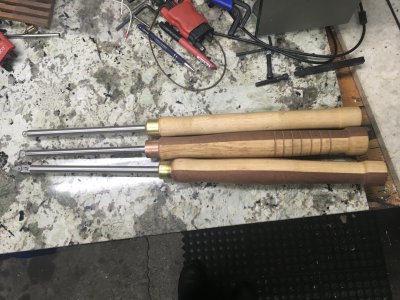-
Welcome back Guest! Did you know you can mentor other members here at H-M? If not, please check out our Relaunch of Hobby Machinist Mentoring Program!
You are using an out of date browser. It may not display this or other websites correctly.
You should upgrade or use an alternative browser.
You should upgrade or use an alternative browser.
Turning wood on my victor lathe, suggestion for tool rest
- Thread starter taiwanluthiers
- Start date
- Joined
- Jul 6, 2022
- Messages
- 171
Yea I think it's partly the wood, it doesn't shave all the way around because of the grain of the wood, so one side cuts well and the other side tears out badly... There's a ton of figuring in taiwan acacia that kinda makes it worse.
I'm turning at 1200 rpm. My lathe can do 1800 rpm but with the rotary phase converter I have sometimes it won't start up without tripping breakers or suspicious smoke coming out of somewhere....
I'm turning at 1200 rpm. My lathe can do 1800 rpm but with the rotary phase converter I have sometimes it won't start up without tripping breakers or suspicious smoke coming out of somewhere....
- Joined
- Jul 6, 2022
- Messages
- 171
I'm having a lot of problem with catching when trying to turn beads with a skew chisel....
- Joined
- Feb 2, 2013
- Messages
- 3,632
I’m interested in the skew chisel too
I have not had much experience with woodworking , but I look forward doing more of it!
I have not had much experience with woodworking , but I look forward doing more of it!
- Joined
- Oct 16, 2019
- Messages
- 6,591
@taiwanluthiers the skew is one of the most difficult wood turning tools to master.
Search Alan Lacer for some great tips on using the skew.
If I were you I'd use a very sharp spindle gouge instead.
Search Alan Lacer for some great tips on using the skew.
If I were you I'd use a very sharp spindle gouge instead.
- Joined
- Jun 6, 2015
- Messages
- 303
I turn wood sometimes with my Hardinge Cataract, and I made a simple clamp on tool rest holder - It was easy for this lathe.
The main problem, most of the time, is that many lathes just cannot turn fast enough for wood -
The Hardinge can spin up well over 3,000 rpm, enough to do even small turnings, pen blanks for example.
I certainly don't do it all the time, and I think my life is just too short to learn to use a skew - I just stick with gouges :~)
The main problem, most of the time, is that many lathes just cannot turn fast enough for wood -
The Hardinge can spin up well over 3,000 rpm, enough to do even small turnings, pen blanks for example.
I certainly don't do it all the time, and I think my life is just too short to learn to use a skew - I just stick with gouges :~)
- Joined
- Jun 15, 2017
- Messages
- 525
I actually made a tool rest for my 16" Eisen, which is supposedly a rebadged Victor. I used a combination of steel, aluminum, and live oak. I can take a picture. I have a Fusion 360 file somewhere for the aluminum part.
- Joined
- Jul 6, 2022
- Messages
- 171
I've been watching videos on skew, and on the videos their skew reacts differently than my experience. For example the skews they use readily takes a shaving from wood, even if the lathe is barely turning at all (for demonstration purpose), yet in my experience it doesn't take shavings nearly as readily as the videos show, in fact it loves to tear out. I do not know if it's the geometry of the skew chisel I'm using (I made it myself with 6x18x200mm HSS blank that is epoxied to a handle, then use a bench grinder to shape it to the right shape). Also I found there's a very fine line between taking a shaving and catching or tearing out. The videos do not really show how it's done.
- Joined
- Jul 29, 2014
- Messages
- 2,743
- Joined
- Jul 6, 2022
- Messages
- 171
Yes I seen a bunch of videos on making your own carbide tool, but my question is, how are you supposed to use them? Do you use them like a scraper?Wood turning got a lot easier and more fun when I used the metal equipment to make some carbide tools. They stay sharp way longer and the longer handles give good control.
View attachment 430485
I found I'm getting better results when I use the skew chisel as a scraper. The finish is nowhere near as good as advertised but it will sand out.


